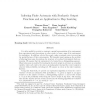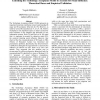73 search results - page 7 / 15 » Constructing utility models from observed negotiation action... |
ICRA
2006
IEEE
14 years 1 months ago
2006
IEEE
— Many application tasks require the cooperation of two or more robots. Humans are good at cooperation in shared workspaces, because they anticipate and adapt to the intentions a...
AAAI
1992
13 years 8 months ago
1992
It is often useful for a robot to construct a spatial representation of its environment from experiments and observations, in other words, to learn a map of its environment by exp...
ICPR
2010
IEEE
14 years 2 months ago
2010
IEEE
We present a method that automatically detects chewing events in surveillance video of a subject. Firstly, an Active Appearance Model (AAM) is used to track a subject’s face acr...
HICSS
1999
IEEE
13 years 11 months ago
1999
IEEE
The Technology Acceptance Model (TAM) represents an important theoretical contribution toward understanding IS usage and IS acceptance behaviors [6, 19]. However, as noted by seve...
ICRA
2008
IEEE
14 years 1 months ago
2008
IEEE
— In this paper, we present an approach allowing a robot to learn a generative model of its own physical body from scratch using self-perception with a single monocular camera. O...


